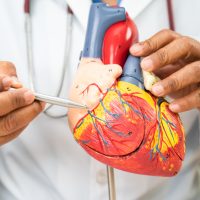Welcome to Upperhill Cardiovascular Center, where exceptional cardiovascular care meets personalized attention. At our state-of-the-art facility, we are dedicated to providing comprehensive heart health services tailored to your individual needs. Our team of experienced cardiologists and specialists use the latest technology and evidence-based practices to diagnose, treat, and manage a wide range of cardiovascular conditions. Whether you are seeking preventive care, advanced treatments, or ongoing management of heart disease, we are here to support you on your journey to better heart health. Your well-being is our top priority, and we are committed to delivering compassionate, high-quality care every step of the way.

Conditions Treated at CardioVascular Health Clinic
Atrial Septal Defect (ASD)
An atrial septal defect (ASD) is a congenital heart defect characterized by an abnormal opening in the atrial septum, the wall that separates the heart’s two upper chambers (the atria).
Atrial Flutter
Atrial flutter is a type of supraventricular arrhythmia characterized by rapid, organized electrical activity in the atria, leading to a distinct “sawtooth” pattern on an electrocardiogram (ECG), often referred to as “f-waves” or “flutter waves.”
Atrial Fibrillation
Atrial fibrillation (AF or AFib) is a common type of arrhythmia, characterized by irregular and often rapid heartbeats originating from the atria, the upper chambers of the heart. This disorder disrupts the normal rhythm of the heart, leading to an erratic and fast heartbeat.
Aortic Stenosis
Aortic stenosis is a heart valve disorder characterized by the narrowing of the aortic valve opening, which obstructs blood flow from the left ventricle into the aorta and onward to the rest of the body. This condition can lead to significant heart problems if left untreated.
Abdominal Aortic Aneurysm?
An abdominal aortic aneurysm (AAA) is a localized enlargement or bulging of the abdominal aorta, the large blood vessel that carries blood from the heart to the rest of the body. This condition can be quite serious because if the aneurysm grows too large.
Bradycardia
Bradycardia is a condition characterized by an abnormally slow heart rate, typically defined as a heart rate below 60 beats per minute. While a slow heart rate can be normal for well-trained athletes or during sleep, bradycardia can indicate an underlying problem.
Aortic dissection
An aortic dissection is a serious condition in which a tear occurs in the inner layer of the body’s main artery (aorta). Blood rushes through the tear, causing the inner and middle layers of the aorta to split (dissect).
Atherosclerosis
Atherosclerosis is the buildup of fats, cholesterol and other substances in and on the artery walls. This buildup is called plaque. The plaque can cause arteries to narrow, blocking blood flow. The plaque also can burst, leading to a blood clot.
Brugada syndrome
Brugada syndrome is a rare but potentially life-threatening heart rhythm condition (arrhythmia) that is sometimes inherited.People with Brugada syndrome have an increased risk of irregular heart rhythms beginning in the lower chambers of the heart (ventricles).
Cardiomyopathy
Cardiomyopathy is a disease of the heart muscle. It causes the heart to have a harder time pumping blood to the rest of the body, which can lead to symptoms of heart failure. Cardiomyopathy also can lead to some other serious heart conditions.
Cardiovascular diseases (CVDs)
Cardiovascular disease is a group of diseases affecting your heart and blood vessels. These diseases can affect one or many parts of your heart and/or blood vessels. A person may be symptomatic (physically experiencing the disease) or asymptomatic (not feeling anything at all).
Congenital heart disease
Congenital heart disease is one or more problems with the heart’s structure that are present at birth. Congenital means that you’re born with the condition. A congenital heart condition can change the way blood flows through the heart.
Angina
Angina is a type of chest pain caused by reduced blood flow to the heart. Angina is a symptom of coronary artery disease.Angina is often described as squeezing, pressure, heaviness, tightness or pain in the chest. It may feel like a heavy weight lying on the chest.
Coronary artery disease
Coronary artery disease (CAD) affects the main blood vessels that supply blood to the heart, called the coronary arteries. In CAD, there is reduced blood flow to the heart muscle. A buildup of fats, cholesterol and other substances in and on the artery walls, atherosclerosis, usually causes coronary artery disease.
Deep vein thrombosis
Deep vein thrombosis (DVT) occurs when a blood clot (thrombus) forms in one or more of the deep veins in the body, usually in the legs. Deep vein thrombosis can cause leg pain or swelling. Sometimes there are no noticeable symptoms.
Diabetes
Diabetes mellitus refers to a group of diseases that affect how the body uses blood sugar (glucose). Glucose is an important source of energy for the cells that make up the muscles and tissues. It’s also the brain’s main source of fuel.
Heart Failure
Heart failure occurs when the heart muscle doesn’t pump blood as well as it should. When this happens, blood often backs up and fluid can build up in the lungs, causing shortness of breath.
Heart valve disease
In heart valve disease, one or more of the valves in the heart doesn’t work properly. There are four heart valves. They keep blood flowing through the heart in the correct direction. Sometimes a valve doesn’t open or close all the way. This can change how blood flows through the heart to the rest of the body.
Acute coronary syndrome
Acute coronary syndrome is a term that describes a range of conditions related to sudden, reduced blood flow to the heart. These conditions include a heart attack and unstable angina.
High cholesterol
Cholesterol is a waxy substance found in your blood. Your body needs cholesterol to build healthy cells, but high levels of cholesterol can increase your risk of heart disease.With high cholesterol, you can develop fatty deposits in your blood vessels. Eventually, these deposits grow, making it difficult for enough blood to flow through your arteries.
Hypertension
High blood pressure is a common condition that affects the body’s arteries. It’s also called hypertension. If you have high blood pressure, the force of the blood pushing against the artery walls is consistently too high. The heart has to work harder to pump blood
Myocardial Infarction (Heart Attack)
A heart attack occurs when the flow of blood to the heart is severely reduced or blocked. The blockage is usually due to a buildup of fat, cholesterol and other substances in the heart (coronary) arteries.
Pericarditis
Pericarditis is swelling and irritation of the thin, saclike tissue surrounding the heart. This tissue is called the pericardium. Pericarditis often causes sharp chest pain. The chest pain occurs when the irritated layers of the pericardium rub against each other.
Stroke
An ischemic stroke occurs when the blood supply to part of the brain is blocked or reduced. This prevents brain tissue from getting oxygen and nutrients.
Vasculitis
Vasculitis involves inflammation of the blood vessels. The inflammation can cause the walls of the blood vessels to thicken, which reduces the width of the passageway through the vessel. If blood flow is restricted, it can result in organ and tissue damage.
Schedule Your Consultation
For personalized cardiovascular care and expert advice, schedule an appointment today and our dedicated professionals will guide you on your journey to better cardiovascular health.









